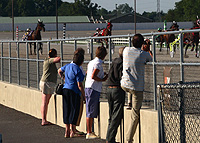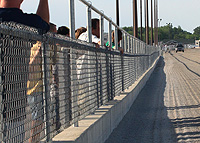![]()
Case Study 3: The See-Through Wall
What do you do when you have a wall that needs to be about seven feet high on one side, but only about five feet high on the other? That was the problem facing Tom Bannon when he worked at Hoosier Park, a pari-mutuel horse racing facility in Anderson, Ind.
 |
 |
"It was a real challenge trying to figure out what to do with that fence," said Bannon. "A few years after Hoosier Park opened the person who was then in charge of operations installed a new fence that was the height needed for the horsemen on the track. But that meant the fence extended over the head of the patrons, and they had to look through it to watch the races. The patrons hated it. We changed the fence back after one day. In fact, the reaction was so bad that we would have changed it back after one race if that was possible!"
So the most obvious solution—raising the height of the fence—wasn't viable. But, the problem still existed. In addition, because the fence was chain link, the track material would wash onto the apron area during a steady rainfall.
"Having track material wash onto the apron during rainy periods was costly," said Bannon. "The apron area is very large and was difficult to keep clean under the best of circumstances. But it was even more difficult when it rained because track material would make it muddy. It took a lot of employee hours to clean it. It was a constant battle. Also, track material is expensive and it was impractical to lose so much of it when it rained."
But what could be done? What could be built that would be low enough for the patrons to see over, but high enough for the needs of the horsemen on the track? Also, could anything be done to keep the material from washing off the track when it rained?
"I tend to do a lot of thinking while mowing the yard," said Bannon. "One day, while doing my yard work, I couldn't stop thinking about how to solve this problem. Finally, it hit me. I realized for it to work we needed different layers of fencing."
Tom thought the base of the fence should be a concrete wall about three or four feet high, with another couple feet of chain link on top of the wall. Finally, about two feet above the chain link would be a single rail. The result would be a fence patrons could see over, but with a top barrier that was sufficient for the needs of the horsemen.
Tom shared his idea the next morning with Hoosier Park President Rick Moore. Moore supported the idea and Tom assembled a team to work on the project. After many meetings and a great deal of creative problem solving by the Hoosier Park team and the vendor hired to do the job, the idea became reality.
"The concrete wall is much more attractive than the original fence, and serves as a barrier to keep the track material from washing onto the apron. That saves money and keeps the facility consistently cleaner," said Bannon. "The chain link on top of the wall allows fans to see the track, and the single railing above that meets the need for the race participants. The area between the fence and the railing serves as sort of a virtual window for patrons to look through. Essentially, we built a see-through wall."
Efficient, cost-effective, and attractive, the see-through wall turned out to be one of Hoosier Park's biggest winners.
When the Rotary Club of Anderson, Ind. needed to organize a fund-raiser to fulfill its $15,000 pledge to Rotary International's Polio Plus campaign, Tom Bannon volunteered to chair an event committee.
How do you make replacing a leaking roof an appealing fund-raiser? You don't make it about the roof.
Working in a team environment is something Tom Bannon enjoys immensely. In 2004, he got an opportunity to work on a team project for Churchill Downs Incorporated (CDI) that was very challenging and rewarding.
Flagship Enterprise Center




